Ubuntu is among the popular operating systems used for production and development purposes. It might be required to try it out or run in the dual-mode without allocating dedicated hardware to it. We can run it as a guest operating system on Windows Operating System using the VMware Workstation Player without actually installing it on dedicated hardware. This tutorial provides all the steps required to install Ubuntu 18.04 LTS as a guest operating system on Windows 10 using the regular installation of VMware Workstation Player 15. The steps should be similar for other Linux operating systems.
Notes: Make sure that your Windows is 64-bit for optimal output and at least 8GB of memory is installed on the system having a multi-core processor to install Ubuntu On VMware Workstation Player. You may also follow the Easy Install Mode of VMware Workstation Player to do the quick installation of Ubuntu using default configurations by skipping the advanced configurations.
Updates: The newer version of this tutorial is available at How To Install Ubuntu 20.04 LTS On Windows Using VMware Workstation Player. You can also follow How To Make Bootable USB Of Ubuntu 20.04 LTS On Windows, How To Make Bootable USB Of Ubuntu 20.04 LTS On Ubuntu, and How To Install Ubuntu 20.04 LTS From Bootable USB to install Ubuntu 20.04 LTS on PC.
Prerequisites
This tutorial assumes that you have access to Windows System with at least 8 GB of memory and VMware Workstation Player is already installed on it. You can also follow How To Install VMware Workstation Player On Windows 10.
Download Ubuntu
Open the Official Page to download the Ubuntu 18.04 LTS Desktop. It provides the options to download Ubuntu Desktop as shown in Fig 1.

Fig 1
Create the Virtual Machine
In this step, we will create the Virtual Machine used to install Ubuntu On VMware Workstation Player. Launch the VMware Workstation Player if it's not running. It will show the Welcome Screen as shown in Fig 2.

Fig 2
Click the Player -> File -> New Virtual Machine OR Create a New Virtual Machine Link as highlighted in Fig 2. Choose the option - I will install the operating system later as shown in Fig 3.

Fig 3
Click the Next Button to choose the Operating System as shown in Fig 4.

Fig 4
Select Linux as the Guest operating system and Ubuntu 64-bit as the Version as shown in Fig 4. Now click the Next Button to configure virtual machine name and installation path as shown in Fig 5.

Fig 5
Click the Next Button to configure the disk and allocate space as shown in Fig 6.

Fig 6
The next screen provides options to confirm the virtual machine as shown in Fig 7.

Fig 7
We can also customize the hardware by clicking the Customize Hardware Button as highlighted in Fig 7. It will show the possible options to configure the virtual machine hardware as shown in Fig 8.

Fig 8
I have allocated 4GB of memory from 16GB and 4 cores from 16 cores to this virtual machine. It might differ on your system depending on your hardware. Also, choose the Ubuntu 18.04 LTS ISO as shown in Fig 8. Now click the Close Button to finalize the hardware for the virtual machine and click Finish Button to create the virtual machine. It will add the Virtual Machine to the VMware library as shown in Fig 9.

Fig 9
Install Ubuntu
In this step, we will install Ubuntu On VMware Workstation Player using the Virtual Machine created by us in the previous step. The player will also provide the options to install VMware Tools for Linux. Installing the VMware Tools is optional at this stage. We can always install it later. VMware Tools is required to have the optimal performance of the guest operating system installed on the virtual machine. Now start the virtual machine by clicking the Play Button as shown in Fig 9. It will start installing the Ubuntu as shown in Fig 10 and provides the options to choose the language as shown in Fig 11.

Fig 10

Fig 11
Choose appropriate language and click the Install Ubuntu Button. It will provide the options to choose the Keyboard Layout as shown in Fig 12.

Fig 12
Now click the Continue Button to choose installation type as shown in Fig 13 and Fig 14.
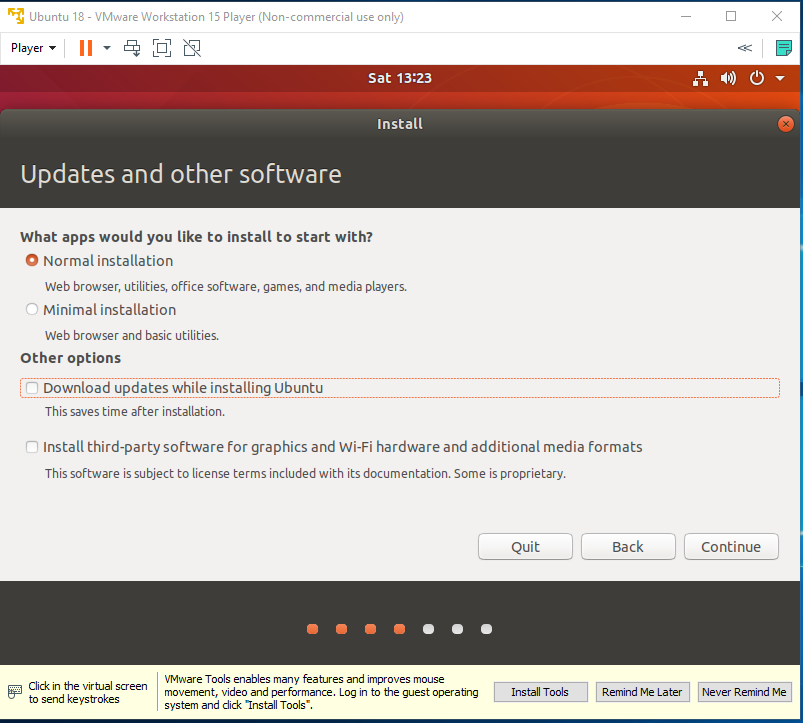
Fig 13

Fig 14
Click the Install Now Button to start installing Ubuntu 18.04. It will also ask to confirm the disk changes as shown in Fig 15.

Fig 15
Now click the Continue Button to choose the Timezone as shown in Fig 16 and also configure the root user as shown in Fig 17.

Fig 16

Fig 17
Now click the Continue Button to continue the installation. It will show the installation progress as shown in Fig 18 and Fig 19.

Fig 18

Fig 19
It will show the success message on completing the installation as shown in Fig 20.

Fig 20
Click the Restart Now Button to restart Ubuntu It will ask to remove the installation media as shown in Fig 21.

Fig 21
Simply press the Enter Key to continue. It will show the login screen as shown in Fig 22 and Fig 23.

Fig 22

Fig 23
Now enter the password provided by you while installing Ubuntu. The player will show the Ubuntu Dashboard as shown in Fig 24 and shows the intro steps as shown in Fig 25.
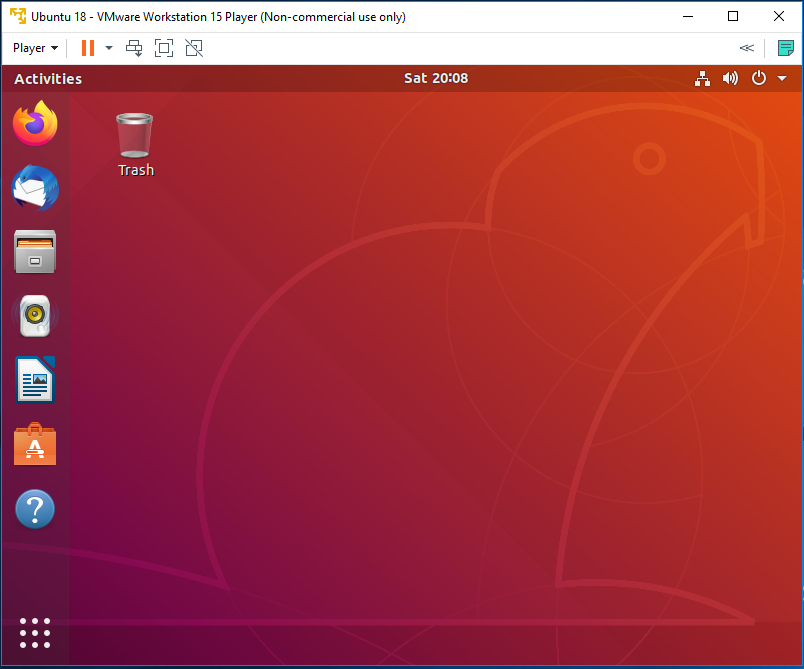
Fig 24
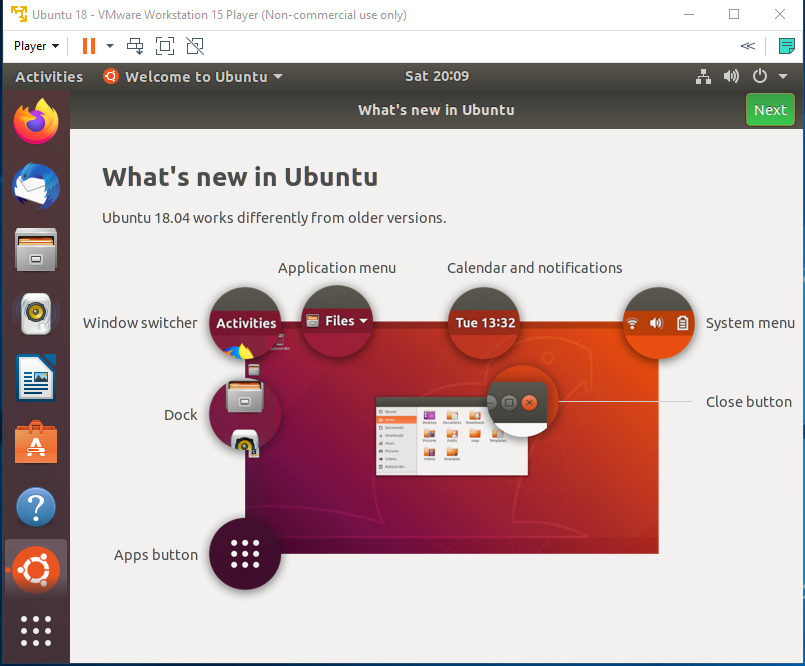
Fig 25
This completes the installation of Ubuntu 18.04 LTS on Windows 10 using the VMware Workstation Player.
Install VMware Tools
It's preferred to install VMware Tools for optimal performance as mentioned by me in the previous step. To get more details, maximize the VMware Workstation Player. We can see that Ubuntu does not cover the entire area of the Window as shown in Fig 26.
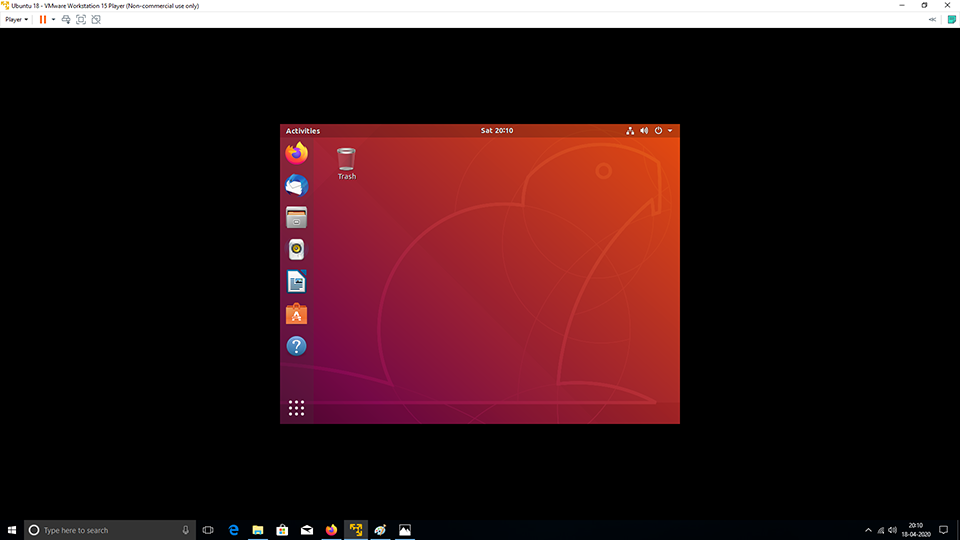
Fig 26
We can resolve this issue by installing VMware Tools. You can follow How To Install VMware Tools In Ubuntu 18.04 LTS.
Suspend, Resume, Stop, and Start
This section provides the options to either Suspend and Resume the virtual machine or to stop and start it.
Click the Pause Icon and click Suspend Guest to suspend the virtual machine as shown in Fig 27. It will save and preserve the state of the guest operating system.

Fig 27
It also asks to confirm the suspension as shown in Fig 28.
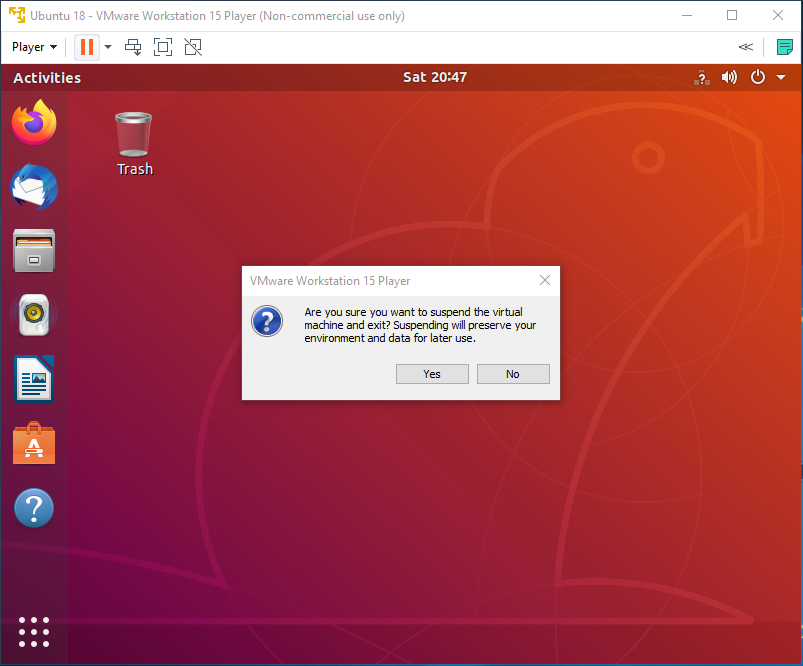
Fig 28
The VMware also shows the snapshot of the guest operating system in the suspended state as shown in Fig 29.

Fig 29
Now click the Play Button to resume it. The player shows the progress while restoring the virtual machine as shown in Fig 30.

Fig 30
It will open the guest operating system at the same state where we have left it. In this way, we won't lose any work.

Fig 31
We can even power off the virtual machine as shown in Fig 32 and Fig 33. The VMware player won't save the state of the powered-off virtual machines.

Fig 32

Fig 33
We can see that there is no snapshot of the powered-off virtual machine.

Fig 34
Summary
This tutorial explained the steps required to download the Ubuntu Desktop Image from the official website of Ubuntu. It also explained the steps to create the virtual machine using the VMware Player and install Ubuntu Desktop as a guest operating system on it. This comes handy in several situations when we do not have options to install Ubuntu directly on the hardware. Keep commenting to join the discussion about installing Ubuntu as a virtual machine on VMware Workstation Player using the comment options as shown below.

